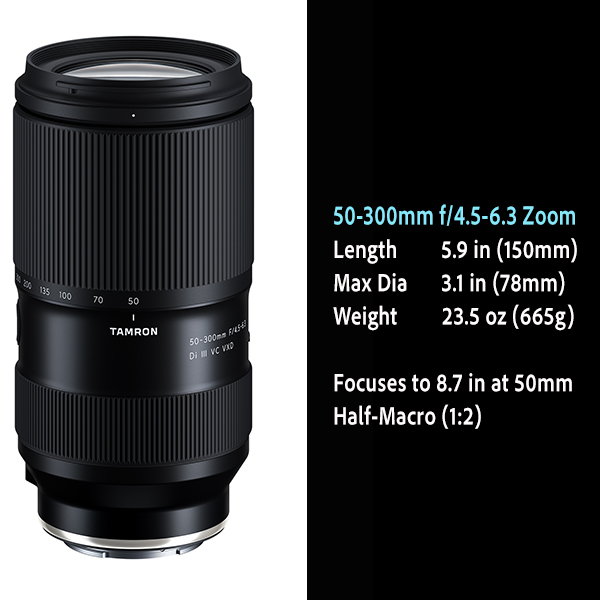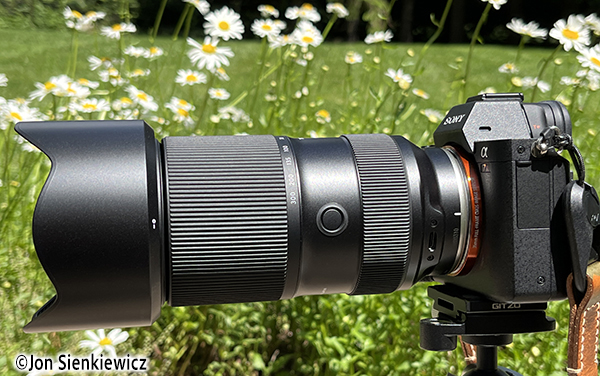Tamron just announced a 50-300mm f/4.5-6.3 zoom for Sony E mount full-frame cameras, and Shutterbug had a chance to evaluate a sample for a few weeks before the new lens was unveiled. That’s not a typo—she’s a 50-300, not a 70-300—and that, as it turns out, makes a huge difference.

Overview & First Impressions
Standing at less than 6-inches tall, the Tamron 50-300mm f/4.5-6.3 is amazingly compact. In comparison, a typical soda can (“pop” can for you Chicagoans) is about 4.8 inches tall, scarcely an inch shorter than the new Tamron 50-300mm. It’s tiny, especially considering it’s a 6X zoom with all of the goodies: Tamron’s potent VC image stabilization technology, Tamron’s high-speed VXD autofocus mechanism, and compatibility with their proprietary Tamron Lens Utility software.
The Tamron 50-300mm zoom is also lightest weight in its class at just 23.5 ounces (665g). For everyday carry, that’s a blessing.

Additional to this, the zoom starts at 50mm (instead of the traditional 70 or 75mm common to 300mm zooms) and provides half-macro (1:2 reproduction) for dynamic closeups. At 50mm the Minimum Object Distance is a scant 8.7 inches. And it delivers exceptionally high image quality overall. Note that when used on Sony mirrorless APS-C format cameras, the equivalent zoom range is 75-450mm; aperture remains the same.

Captured with a Sony Alpha A7RII and Tamron 50-300mm f/4.5-6.3 zoom. Zoomed during 1/25 sec exposure at f/29, ISO 50, on an overcast June day. ©Jon Sienkiewicz
Starting at 50mm offers numerous functional benefits; getting more of the subject into the frame is the obvious plus. If you enjoy creating unique imagery by zooming during exposure (as I did while shooting the photo at the top of this story) the wider starting point produces greater impact.
Furthermore, starting at 50mm is grounded in science, too. A 50mm lens perceives perspectives approximately the same way our eyes do. The “normal” focal length for any imaging sensor is equal to its diagonal. For example, a 35mm film frame measures 24 x 36mm and has a diagonal of 43.27mm (thank you, Pythagoras). 50mm, which measures almost exactly 2 inches (1.97), was conveniently designated the “standard” or “normal” focal length for 35mm film cameras way back when. Nerds can take a deeper dive into the math behind the 50mm normal lens notion here: What’s a “Normal” Lens? And Why Is My 18mm Lens “Equivalent” to a 28mm?
Bearing the official full name “TAMRON 50-300mm F/4.5-6.3 Di III VC VXD (Model A069),” the compact new zoom will be available for $799 in Sony E full-frame mount on June 27 of this year—a couple weeks away as this is written.
Specifications

Features Summary
In addition the those outlined above, the Tamron 50-300mm f/4.5-6.3 offers several other features that have become synonymous with the Tamron brand. These include weather-resistant seals at critical junctures, fluorine coating on the front element for dust and fingerprint repulsion, Tamron’s BBAR-G2 (Broad-Band Anti-Reflection Generation 2) Coating for ghost/flare suppression, and a Focus Set Button for assigning camera functions and Tamron Lens Utility options.
The Tamron 50-300mm f/4.5-6.3 is compatible with many Sony Alpha in-camera features, including Fast Hybrid AF and Eye AF. In other words, you can make full use of your camera’s advanced functions.

Although it may seem like a small detail, the filter thread on this new zoom is 67mm, the same size found on nearly every Tamron mirrorless lens. This enables sharing of filters across lens models and interchange of front lens caps. This means you do not have to buy multiple sizes of pricy Polarizers or NDs to fit different lenses, so you save a few bucks.
The Tamron 50-300mm f/4.5-6.3 is equipped with a USB-C port that connects to the Tamron Lens Utility software running on a computer or mobile smart device. The software facilitates firmware updates when necessary, and customization of certain lens functions.

Exterior Construction: Fit & Finish
Befitting its class-leading compact size and light weight, the Tamron 50-300mm f/4.5-6.3 is well-balanced on a Sony Alpha mirrorless and fits nicely in the hand. The construction details are flawless, as expected from Tamron, and the semi-matte black finish looks great on a black camera body.
The zoom ring turns smoothly without drag or sloppiness. The metal lens mount snaps tight and secure. There’s a zoom lock, but even without it I did not encounter zoom creep (unintended zoom extension when the camera is carried lens downward).

Optical Construction
The optical formula of 19 elements in 22 groups includes two Low Dispersion and two Extra Low Dispersion components to thwart aberrations and provide peak image quality throughout the full expanse of the zoom range.

Performance Summary
Outstanding sharpness from edge to edge at all focal lengths and all apertures, excellent neutral color fidelity and crisp acutance. Contrast is clean and I did not encounter annoying aberrations of any kind. I got amazing results shooting closeups at 1:2 magnification ratio and equally astounding shots at 300mm telephoto.

Conclusion
It’s less than 6-inches long and weighs less than 1.5 pounds. It’s a 300mm telephoto and a 50mm normal lens—and everything in between. Plus it’s a 1:2 (one-half life size) macro lens. And it’s crazy sharp. On top of all this, it’s bargain-priced at $799.
If you still need more reasons to buy it, I suspect those Krispy Kreme donuts you’ve been secretly snacking have glazed your prefrontal cortex.
Seriously, this zoom has so much to offer, it belongs in the bag of everyone who owns a Sony Alpha mirrorless camera.

Price & Availability
The Tamron 50-300mm F/4.5-6.3 Di III VC VXD (Model A069) for Sony E-mount full-frame (and APS-C format) mirrorless cameras will be shipping on June 27, 2024 at $799 in the US. Not in time for Father’s Day, but I think Pops will take an IOU in this case.
Find an Authorized Tamron Americas Dealer by clicking here. Subscribe to Tamron’s eNewsletter here to receive pro tips, new product info and special offerings.
—Jon Sienkiewicz


















